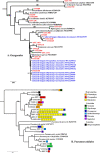Breathing can be dangerous: Opportunistic fungal pathogens and the diverse community of the small mammal lung mycobiome
- PMID: 37746221
- PMCID: PMC10512277
- DOI: 10.3389/ffunb.2022.996574
Breathing can be dangerous: Opportunistic fungal pathogens and the diverse community of the small mammal lung mycobiome
Abstract
Human lung mycobiome studies typically sample bronchoalveolar lavage or sputum, potentially overlooking fungi embedded in tissues. Employing ultra-frozen lung tissues from biorepositories, we obtained fungal ribosomal RNA ITS2 sequences from 199 small mammals across 39 species. We documented diverse fungi, including common environmental fungi such as Penicillium and Aspergillus, associates of the human mycobiome such as Malassezia and Candida, and others specifically adapted for lungs (Coccidioides, Blastomyces, and Pneumocystis). Pneumocystis sequences were detected in 83% of the samples and generally exhibited phylogenetic congruence with hosts. Among sequences from diverse opportunistic pathogens in the Onygenales, species of Coccidioides occurred in 12% of samples and species of Blastomyces in 85% of samples. Coccidioides sequences occurred in 14 mammalian species. The presence of neither Coccidioides nor Aspergillus fumigatus correlated with substantial shifts in the overall mycobiome, although there was some indication that fungal communities might be influenced by high levels of A. fumigatus. Although members of the Onygenales were common in lung samples (92%), they are not common in environmental surveys. Our results indicate that Pneumocystis and certain Onygenales are common commensal members of the lung mycobiome. These results provide new insights into the biology of lung-inhabiting fungi and flag small mammals as potential reservoirs for emerging fungal pathogens.
Keywords: Aspergillus fumigatus; Blastomyces; Coccidioides; Onygenales; Pneumocystis; Valley fever.
Copyright © 2022 Salazar-Hamm, Montoya, Montoya, Cook, Liphardt, Taylor, Cook and Natvig.
Conflict of interest statement
The authors declare that the research was conducted in the absence of any commercial or financial relationships that could be construed as a potential conflict of interest.
Figures





Similar articles
-
Mycobiome Sequencing and Analysis Applied to Fungal Community Profiling of the Lower Respiratory Tract During Fungal Pathogenesis.Front Microbiol. 2019 Mar 15;10:512. doi: 10.3389/fmicb.2019.00512. eCollection 2019. Front Microbiol. 2019. PMID: 30930884 Free PMC article.
-
Phylogenetic and ecological drivers of the avian lung mycobiome and its potentially pathogenic component.Commun Biol. 2025 Apr 19;8(1):634. doi: 10.1038/s42003-025-08041-8. Commun Biol. 2025. PMID: 40253508 Free PMC article.
-
Corticosteroid treatment is associated with increased filamentous fungal burden in allergic fungal disease.J Allergy Clin Immunol. 2018 Aug;142(2):407-414. doi: 10.1016/j.jaci.2017.09.039. Epub 2017 Nov 6. J Allergy Clin Immunol. 2018. PMID: 29122659
-
Advances in the diagnosis of fungal pneumonias.Expert Rev Respir Med. 2020 Jul;14(7):703-714. doi: 10.1080/17476348.2020.1753506. Epub 2020 Apr 21. Expert Rev Respir Med. 2020. PMID: 32290725 Free PMC article. Review.
-
Recent Trends in the Epidemiology of Fungal Infections.Infect Dis Clin North Am. 2021 Jun;35(2):237-260. doi: 10.1016/j.idc.2021.03.001. Infect Dis Clin North Am. 2021. PMID: 34016277 Free PMC article. Review.
Cited by
-
Advancing the central role of non-model biorepositories in predictive modeling of emerging pathogens.PLoS Pathog. 2023 Jun 15;19(6):e1011410. doi: 10.1371/journal.ppat.1011410. eCollection 2023 Jun. PLoS Pathog. 2023. PMID: 37319170 Free PMC article. No abstract available.
-
Three distinct forms of Pneumocystis coexist in individuals of two species of deer mice (genus Peromyscus).Infect Genet Evol. 2025 Aug;132:105767. doi: 10.1016/j.meegid.2025.105767. Epub 2025 May 21. Infect Genet Evol. 2025. PMID: 40409476
-
Retracing the evolution of Pneumocystis species, with a focus on the human pathogen Pneumocystis jirovecii.Microbiol Mol Biol Rev. 2024 Jun 27;88(2):e0020222. doi: 10.1128/mmbr.00202-22. Epub 2024 Apr 8. Microbiol Mol Biol Rev. 2024. PMID: 38587383 Free PMC article. Review.
-
Coccidioidomycosis seasonality in California: a longitudinal surveillance study of the climate determinants and spatiotemporal variability of seasonal dynamics, 2000-2021.Lancet Reg Health Am. 2024 Aug 19;38:100864. doi: 10.1016/j.lana.2024.100864. eCollection 2024 Oct. Lancet Reg Health Am. 2024. PMID: 39253708 Free PMC article.
-
Choclo virus (CHOV) recovered from deep metatranscriptomics of archived frozen tissues in natural history biorepositories.PLoS Negl Trop Dis. 2024 Jan 12;18(1):e0011672. doi: 10.1371/journal.pntd.0011672. eCollection 2024 Jan. PLoS Negl Trop Dis. 2024. PMID: 38215158 Free PMC article.
References
-
- Akbar H., Pinçon C., Aliouat-Denis C. M., Derouiche S., Taylor M. L., Pottier M., et al. (2012). Characterizing Pneumocystis in the lungs of bats: understanding Pneumocystis evolution and the spread of Pneumocystis organisms in mammal populations. Appl. Environ. Microbiol. 78, 8122–8136. doi: 10.1128/AEM.01791-12 - DOI - PMC - PubMed
-
- Alexander L. F., Riddle B. R. (2005). Phylogenetics of the new world rodent family heteromyidae. J. Mammal. 86, 366–379. doi: 10.1644/BER-120.1 - DOI

